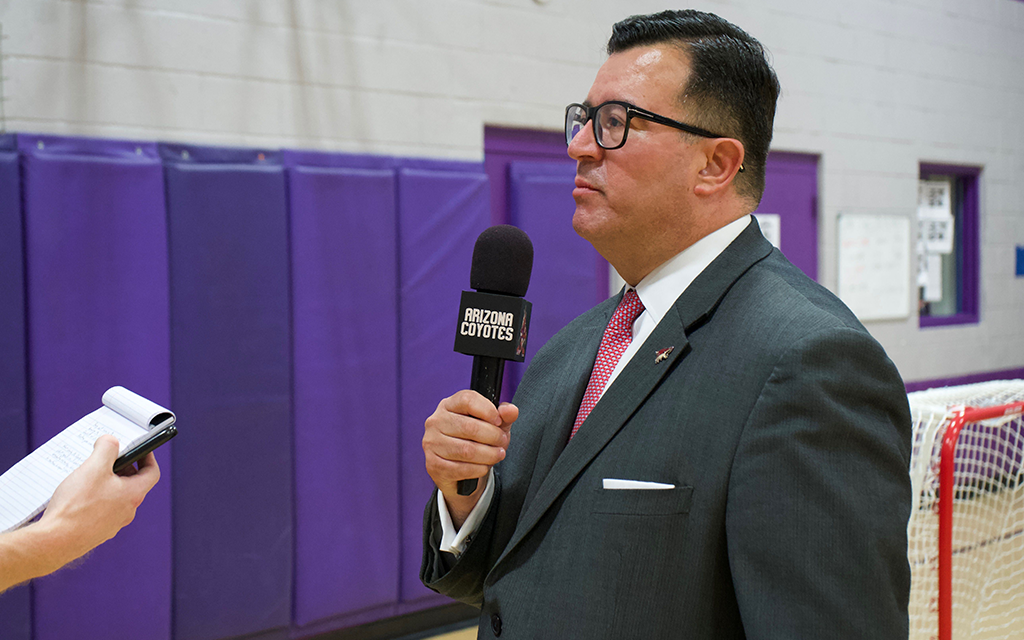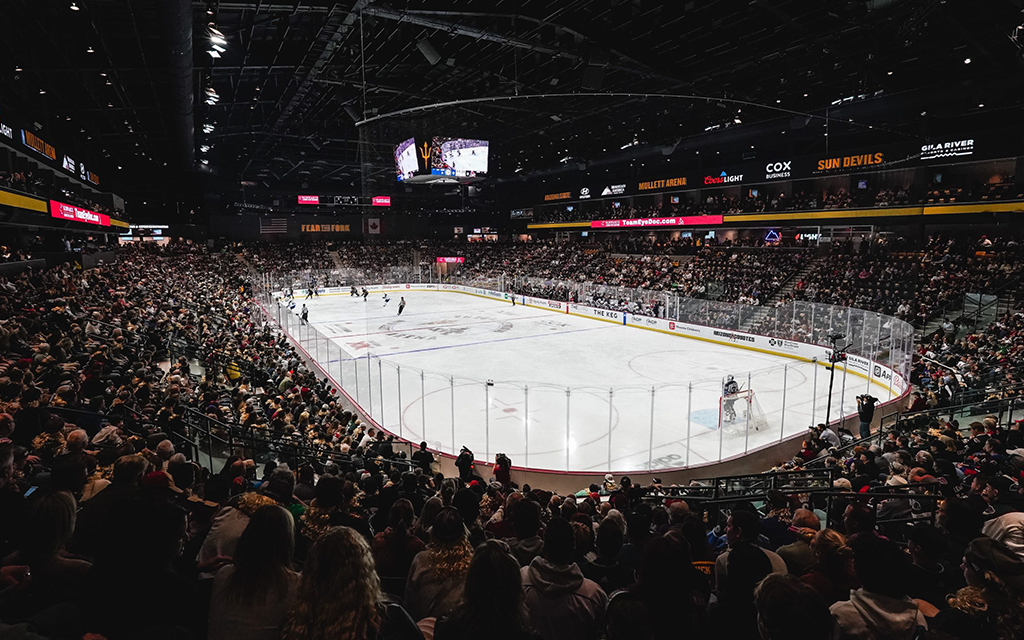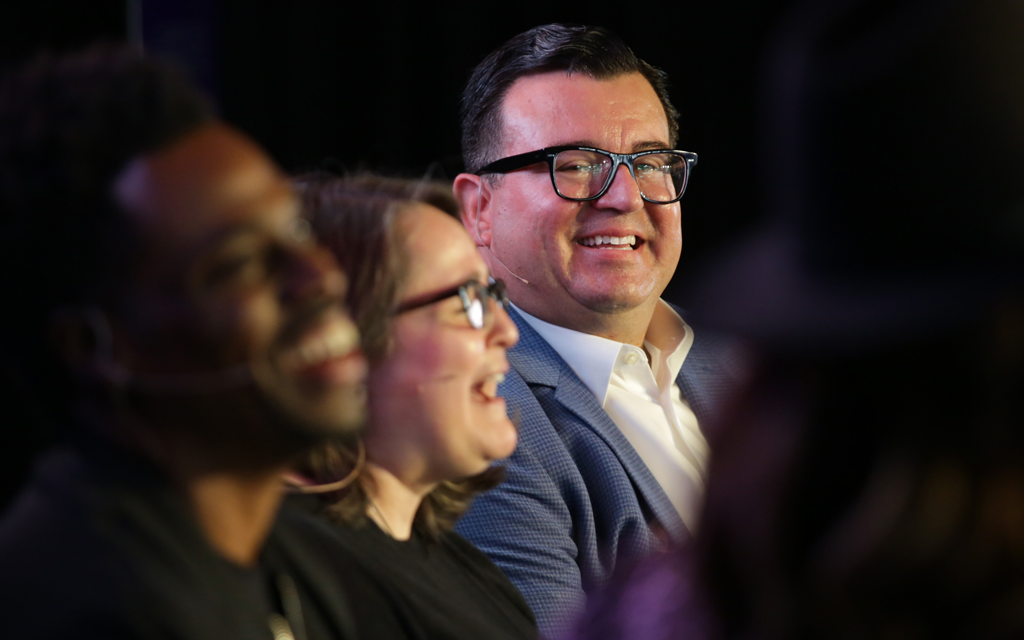TEMPE – The packed 5,000-seat Mullett Arena in downtown Tempe houses two Arizona hockey organizations.
Both teams feature a raucous student section on game nights, with many young fans rocking mullets – natural or wig – while wearing their team’s sweaters and heckling opposing goalies or chanting in unison.
Arizona State’s hockey program and the NHL’s Arizona Coyotes are sharing Mullett Arena while the Coyotes try to negotiate construction of their own new home.
“We’re very grateful that ASU allowed us to be on their campus,” Coyotes President & CEO Xavier A. Gutierrez said. “It’s been great from the business perspective, what you saw last year was Mullett magic. Not only did we have the eighth-best record in the NHL in terms of a home record, and the best home record that we’d had in a very, very long time but off the ice, we had the highest ticket revenue we’d ever had.”
The relationship between the two Arizona hockey programs has bore fruit for both sides and has made both teams more successful on and off the ice. It’s a sign of growth for the sport in the desert, where many once predicted hockey could not succeed. With more and more ASU players turning professional and the Coyotes continuing their push as a young team, the two sides are growing together.
The proof is in the numbers. During the 2021-22 season, which was the team’s final season in the 17,125-seat Gila River Arena in Glendale, the Coyotes didn’t sell out a single game while leaving on average 5,000 empty seats. When the team took temporary roots at the smaller Mullett Arena for the 2022-23 season, the Coyotes sold out every single game in a more intimate atmosphere. Season ticket revenue also rose 50% during the move.
The ASU men’s hockey program also saw similar success during the 2022-23 season averaging 4,406 fans per game, which is a near sellout. The ASU crowds included many NHL fans, mostly Coyotes followers, who came to watch future NHL stars play.
The Coyotes’ franchise value has also risen since playing at Mullett. Coyotes owner Alex Meruelo purchased the club in 2019 for $300 million. The value of the franchise is now $450 million, which is a 13% increase according to Forbes magazine.
The teams have forged a relationship to improve the hockey scene in Arizona, but their relationship didn’t just begin with their Mullett Arena arrangement. The two hockey clubs have been in association for a while.
The relationship between the two started in 2015, when ASU joined the NCAA as a Division I hockey program. The Coyotes decided to create a partnership between the two that would allow ASU to play at Gila River Arena, and attempt to attract more ASU students to attend their home games.
“When we first heard rumblings of ASU going to Division I, we immediately reached out to (ASU) coach (Greg Powers) and through some of the administrative staff, then came our willingness and absolute desire to become part of the program in any way possible,” former Coyotes president Anthony LeBlanc said in the press conference when the collaboration was first announced on August 5, 2015.
The Coyotes also announced plans a year later to build a 16,000-seat arena in ASU’s athletic district with a 4,000-seat arena attached to the building. Unfortunately for the team, the project failed when Arizona State pulled out of the plan in 2017, saying, “The university has no intention of proceeding to sign a development agreement with the Coyotes.”
A couple of years later, with the Coyotes only making the playoffs once since 2015 and mired in a troubling relationship with the city of Glendale, the team was kicked out of Gila River Arena. The Coyotes searched for potential suitors to house the team while they figured out a place to build a permanent home.
Finally, the Coyotes approached ASU about playing in Mullett even before construction was complete. After reaching an agreement with the team that involved a behavior agreement (due to the rocky relationship the Coyotes had with the city of Glendale while playing in their previous home) and that gave ASU priority, along with the Coyotes paying for additions that would make the facility NHL-approved, the school allowed the NHL team to share the facility until the Coyotes built their new arena.
“We are thrilled that we have arranged to play our home games in Arizona State University’s new multi-purpose arena starting next season,” Gutierrez said in a statement. “This will be an incredible, intimate, and exciting fan experience in a state-of-the-art new arena in a fantastic location in the heart of Tempe.”
The Coyotes built several additions to Mullett Arena that will be used long after the team leaves. The ASU men’s hockey team will use the NHL locker room and facilities while the current NCAA locker room leaves the possibility for a women’s hockey team or another hockey team to play frequently out of Mullett.
With the move across the Valley in place, the Coyotes made sure to capitalize on the opportunity to attract more fans to their games. The team created Coyotes University, a program where ASU (and GCU) students can get discounted tickets, along with potential internship opportunities and additional engagement with the team. The Coyotes also created the P.U.C.K. internship program, which allows students to do multiple jobs with the team throughout the season.
It’s safe to say that this time around, the idea worked. The student section of the brand-new Mullett Arena last season was filled with fans during every game. Each Coyotes game was sold out and the ASU students made their presence felt.
“I was interviewed in that pit during that first game and people couldn’t hear me,” Gutierrez said. “That’s what we wanted. Young people, especially those ASU students, brought that heat to the Mullett.”
The program was so successful that the Coyotes are bringing it back this season and hoping to improve the experience for their newly found young fanbase.
“We’re going to continue to expand it,” Gutierrez said. “We want more and more engagement with ASU, not only the students but the alumni. We think that’s absolutely something that this experience is unique in … and so we’re going to lean into it again this year.”

President & CEO Xavier A. Gutierrez highlights record-breaking ticket revenue and the fan experience as two key successes from the collaboration between ASU’s hockey program and the Arizona Coyotes. (File photo by Jake Santo/Cronkite News)
The fans aren’t the only ones who are excited. Coyotes players, including former Minnesota Gopher and 2021 third-overall pick Logan Cooley, are looking forward to playing at the arena and getting a taste of what they call Mullett magic.
Cooley made an impact at Mullett when Minnesota played Arizona State last year. He scored an impressive lacrosse-like goal as a Gopher that left the home team speechless. Now he looks to score some more jaw-dropping goals, but in the favor of the home crowd this time.
“When I played there (it) was an unbelievable atmosphere,” Cooley said. “I’m looking forward to wearing a different uniform this time, and hopefully having the home crowd cheering for me, not against me. I’m looking forward to it. It’s going to be fun, and I’ve heard nothing but great things about it.”
The Coyotes and ASU collaborated multiple times last season, beginning with the Coyotes’ first game at Mullett when the ceremonial puck was dropped by Shane Doan, the Coyotes franchise scoring leader, and his son Josh Doan. The Coyotes also hosted ASU night, ASU released collaboration merchandise and the Coyotes congratulated the ASU women’s hockey team during a game after the club made it to nationals for the first time.
The Doan’s father-son link magnifies the Arizona teams’ connection. The Coyotes drafted Josh, a winger, with their second-round pick in 2021. Shane’s son played two seasons for the Sun Devils. He was named captain in his final year before signing his entry-level NHL contract and playing with the Coyotes’ AHL affiliate Tucson Roadrunners.
He hopes to become the third Sun Devil in history to play in an NHL game behind Seattle Kraken goaltender Joey Daccord and former San Jose Sharks defenseman Brinson Pasichnuk. Doan would also be the first former ASU forward to play in the league, which could help increase overall interest in the Sun Devils.
With the team’s improvement off the ice as new rookies Cooley and Dylan Guenther look to help veterans like Clayton Keller make a push for the playoffs and the team announcing its intent to purchase land in Mesa, the Coyotes will not forget who has helped through difficult struggles.
The burst of energy from fans as they crowd into Mullett Arena is palpable. It can be seen in their wild swinging mullets and heard in their full-throated chants.
“That’s what we wanted,” Gutierrez said. “The youth, especially those ASU students, they brought that heat to the Mullett.”


